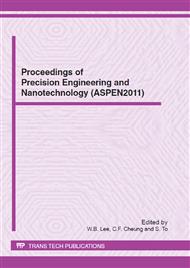p.606
p.612
p.618
p.624
p.629
p.634
p.640
p.645
p.651
Generation and Control of Wide-Field Three-Dimensional Structured Illumination for Advanced Microscopic Imaging
Abstract:
In a variety of practical microscopic imaging applications, many industries require not only lateral resolution improvement but also axial resolution improvement. The resolution in optical microscopy is limited by diffraction and determined by the wavelength of the incident light and the numerical aperture (NA) of the objective lens. The diffraction limit is mathematically described by a point spread function in the imaging system, and three-dimensional (3D) point spread functions describe both the lateral and axial resolutions. Thus, it is useful to focus on exceeding this limit and improving the resolution of optical imaging by the spatial control of structured illumination. Structured illumination microscopy is a familiar technique to improve resolution in fluorescent imaging, and it is expected to be applied to industrial applications. Microscopic imaging is convenient, non-destructive, and has a high-throughput performance and compatibility with a number of applications. However, the spatial resolution of conventional light microscopy is limited to wavelength scale and the depth of field is shallow; hence, it is difficult to obtain detailed 3D spatial data of the object to be measured. Here, we propose a new technique for generating and controlling wide-field 3D structured illumination. The technique, based on the 3D interference of multiple laser beams, provides lateral and axial resolution improvement, and a wide 3D field of view. The spatial configuration of the beams was theoretically examined and the optimal incident angle of the multiple beams was confirmed. Numerical simulations using the finite difference time domain (FDTD) method were carried out and confirmed the generation of 3D structured illumination and spatial control of the illumination by using the phase shift of incident beams.
Info:
Periodical:
Pages:
640-644
Citation:
Online since:
June 2012
Authors:
Price:
Сopyright:
© 2012 Trans Tech Publications Ltd. All Rights Reserved
Share:
Citation:


